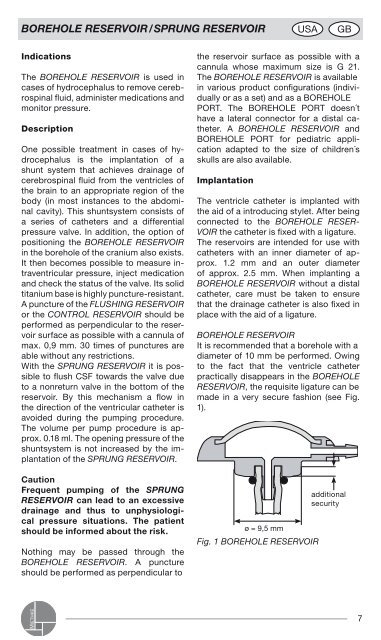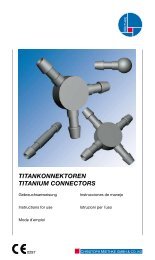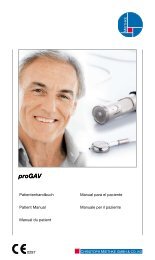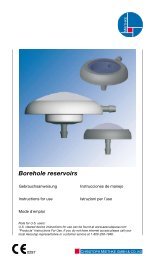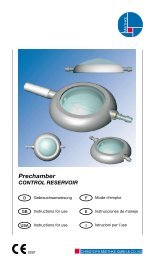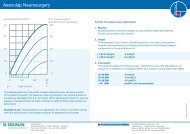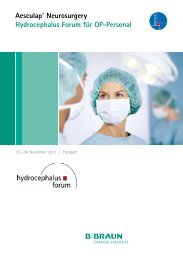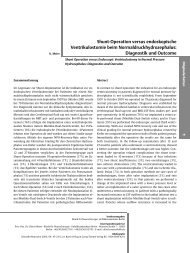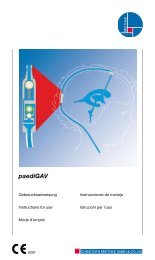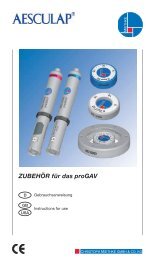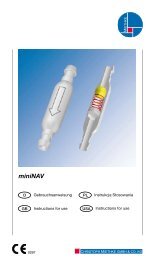borehole reservoir sprung reservoir - Christoph Miethke GmbH & Co ...
borehole reservoir sprung reservoir - Christoph Miethke GmbH & Co ...
borehole reservoir sprung reservoir - Christoph Miethke GmbH & Co ...
You also want an ePaper? Increase the reach of your titles
YUMPU automatically turns print PDFs into web optimized ePapers that Google loves.
BOREHOLE RESERVOIR/SPRUNG RESERVOIR<br />
Indications<br />
The BOREHOLE RESERVOIR is used in<br />
cases of hydrocephalus to remove cerebrospinal<br />
fluid, administer medications and<br />
monitor pressure.<br />
Description<br />
One possible treatment in cases of hydrocephalus<br />
is the implantation of a<br />
shunt system that achieves drainage of<br />
cerebrospinal fluid from the ventricles of<br />
the brain to an appropriate region of the<br />
body (in most instances to the abdominal<br />
cavity). This shuntsystem consists of<br />
a series of catheters and a differential<br />
pressure valve. In addition, the option of<br />
positioning the BOREHOLE RESERVOIR<br />
in the <strong>borehole</strong> of the cranium also exists.<br />
It then becomes possible to measure intraventricular<br />
pressure, inject medication<br />
and check the status of the valve. Its solid<br />
titanium base is highly puncture-resistant.<br />
A puncture of the fLuSHIng RESERVOIR<br />
or the COntROL RESERVOIR should be<br />
performed as perpendicular to the <strong>reservoir</strong><br />
surface as possible with a cannula of<br />
max. 0,9 mm. 0 times of punctures are<br />
able without any restrictions.<br />
With the SpRung RESERVOIR it is possible<br />
to flush CSF towards the valve due<br />
to a nonreturn valve in the bottom of the<br />
<strong>reservoir</strong>. By this mechanism a flow in<br />
the direction of the ventricular catheter is<br />
avoided during the pumping procedure.<br />
The volume per pump procedure is approx.<br />
0.18 ml. The opening pressure of the<br />
shuntsystem is not increased by the implantation<br />
of the SpRung RESERVOIR.<br />
Caution<br />
Frequent pumping of the SPRUNG<br />
RESERVOIR can lead to an excessive<br />
drainage and thus to unphysiological<br />
pressure situations. The patient<br />
should be informed about the risk.<br />
Nothing may be passed through the<br />
BOREHOLE RESERVOIR. A puncture<br />
should be performed as perpendicular to<br />
MIETHKE<br />
USA<br />
GB<br />
the <strong>reservoir</strong> surface as possible with a<br />
cannula whose maximum size is G 21.<br />
The BOREHOLE RESERVOIR is available<br />
in various product configurations (individually<br />
or as a set) and as a BOREHOLE<br />
PORT. The BOREHOLE PORT doesn´t<br />
have a lateral connector for a distal catheter.<br />
A BOREHOLE RESERVOIR and<br />
BOREHOLE PORT for pediatric application<br />
adapted to the size of children´s<br />
skulls are also available.<br />
Implantation<br />
The ventricle catheter is implanted with<br />
the aid of a introducing stylet. After being<br />
connected to the BOREHOLE RESER-<br />
VOIR the catheter is fixed with a ligature.<br />
The <strong>reservoir</strong>s are intended for use with<br />
catheters with an inner diameter of approx.<br />
1.2 mm and an outer diameter<br />
of approx. 2.5 mm. When implanting a<br />
BOREHOLE RESERVOIR without a distal<br />
catheter, care must be taken to ensure<br />
that the drainage catheter is also fixed in<br />
place with the aid of a ligature.<br />
BOREHOLE RESERVOIR<br />
It is recommended that a <strong>borehole</strong> with a<br />
diameter of 10 mm be performed. Owing<br />
to the fact that the ventricle catheter<br />
practically disappears in the BOREHOLE<br />
RESERVOIR, the requisite ligature can be<br />
made in a very secure fashion (see Fig.<br />
1).<br />
ø = 9,5 mm<br />
fig. 1 BOREHOLE RESERVOIR<br />
additional<br />
security<br />
7


